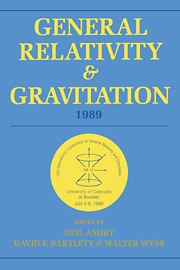 General Relativity and Gravitation, 1989
General Relativity and Gravitation, 1989 Book contents
- Frontmatter
- Contents
- Preface
- Conference committees
- Part A Classical relativity and gravitation theory
- 1 Colliding waves in general relativity
- 2 How fast can pulsars spin?
- 3 Global properties of solutions to Einstein's equations
- 4 Progress in 3D numerical relativity
- WORKSHOPS
- Part B Relativistic astrophysics, early universe, and classical cosmology
- WORKSHOPS
- Part C Experimental gravitation and gravitational wave detection
- WORKSHOPS
- Part D Quantum gravity, superstrings, quantum cosmology
- WORKSHOPS
- Part E Overviews-past, present, and future
3 - Global properties of solutions to Einstein's equations
Published online by Cambridge University Press: 05 March 2012
- Frontmatter
- Contents
- Preface
- Conference committees
- Part A Classical relativity and gravitation theory
- 1 Colliding waves in general relativity
- 2 How fast can pulsars spin?
- 3 Global properties of solutions to Einstein's equations
- 4 Progress in 3D numerical relativity
- WORKSHOPS
- Part B Relativistic astrophysics, early universe, and classical cosmology
- WORKSHOPS
- Part C Experimental gravitation and gravitational wave detection
- WORKSHOPS
- Part D Quantum gravity, superstrings, quantum cosmology
- WORKSHOPS
- Part E Overviews-past, present, and future
Summary
Introduction
The methods invented so far to develop conjectures on and to work out the details of the time evolution of gravitational fields fall into two classes. The first class comprises “physical considerations,” techniques of differential geometry and topology and other ideas which do not take into account the field equations while the remaining methods like: study of explicit solutions, of the Cauchy problem local in time (with its important related notions like “domain of dependence,” “Cauchy stability,” etc.), of formal expansion type solutions, of approximation procedures, etc., have been used to derive information about the evolution more or less directly from the field equations. The division above is somewhat artificial, as is illustrated e.g. by the use of certain positivity assumptions together with Raychaudhuri's equations in the proof of the Hawking-Penrose singularity theorems. However, since the field equations are used in this case in a very weak way one obtains quite general results about the occurrence of a non-complete geodesic but almost no information about the expected “singularity.”
In spite of all the ingenuity with which the methods indicated above have been employed, the important open problems of classical general relativity, e.g. the development and (causal) structure of singularities and the formation of horizons etc. for space-times arising from regular data, the asymptotic behavior of gravitational fields and the relation between the far fields and the structure of the sources etc., remained to a large extent unsolved.
- Type
- Chapter
- Information
- General Relativity and Gravitation, 1989Proceedings of the 12th International Conference on General Relativity and Gravitation, pp. 41 - 60Publisher: Cambridge University PressPrint publication year: 1990


